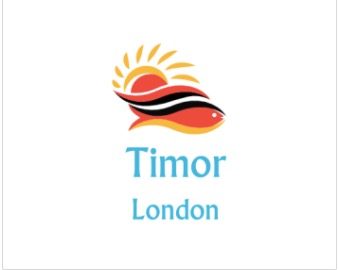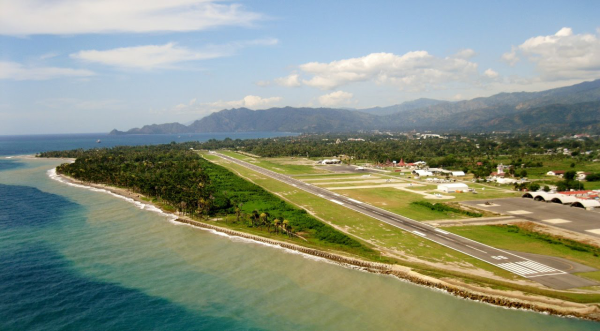via Tourism in Dili, Timor Leste: Can it help to cure or will it make things worse?
Author: timorlondon
Tourism in Dili, Timor Leste: Can it help to cure or will it make things worse?
Current Toursim Development in East Timor
In 1999, after a bitter struggle for many years, Timor Leste (in English East Timor) gained independence from Indonesia, which had occupied it since the Portuguese colonial rule was withdrawn in 1975. Since establishing its own government, problems have remained, most notably conflict between different factions of the community leading to violence and destruction on several occasions. This has meant reliance on support from UN peace keeping forces and Australian and Portuguese troops over the last 10 years. The western part of the island of Timor is still part of Indonesia. Australia is the nearest neighbour of the developed world, lying 400 km south east and it is from there that many business contacts and political links have been formed. The country is largely mountainous and heavily forested, with a tropical climate.
The population of Timor-Leste is around 1.1 million, with 75%, or 785,000 people, classified as living in rural…
View original post 2,339 more words
Las Vegas Massacre: What We Know So Far *UPDATED 10/4/2017* — The American Times
By: Zack Duvall 10/04/2017 UPDATE: New Developments in the investigation into the Sunday night massacre carried out by Stephan Paddock, a 64-year old multi-millionaire, have emerged and are providing new insight to the events leading up to the deadly shooting. Officials have confirmed that in the week leading up to Sunday night, Paddock had wired […]
via Las Vegas Massacre: What We Know So Far *UPDATED 10/4/2017* — The American Times
Tourism in Dili, Timor Leste: Can it help to cure or will it make things worse?
In 1999, after a bitter struggle for many years, Timor Leste (in English East Timor) gained independence from Indonesia, which had occupied it since the Portuguese colonial rule was withdrawn in 1975. Since establishing its own government, problems have remained, most notably conflict between different factions of the community leading to violence and destruction on several occasions. This has meant reliance on support from UN peace keeping forces and Australian and Portuguese troops over the last 10 years. The western part of the island of Timor is still part of Indonesia. Australia is the nearest neighbour of the developed world, lying 400 km south east and it is from there that many business contacts and political links have been formed. The country is largely mountainous and heavily forested, with a tropical climate.
The population of Timor-Leste is around 1.1 million, with 75%, or 785,000 people, classified as living in rural areas. Timor-Leste has valuable natural resources, including one of the world’s most vital commodities, petroleum. according to the 2010 census. At present 80% of the working population are employed in the rural agriculture industry, while there is very little service sector in the capital city of Dili. Across the country unemployment and under-employment are estimated to be as high as 70% (ibid) it is estimated that over the next 16 years the youth of the country, already a large part of the total population, will be doubled (UNDP).
In recent years East Timor’s oil and gas reserves have been realised and strategic negotiations have taken place in order to retain some financial benefit of this within the country. This has meant that, despite being a fledgling nation, it has found itself with a certain amount of economic growth. Recently East Timorese finance minister spoke of how the country had made a remarkable recovery since the unrest and violence of 2006 (RMIT University 2011), experiencing a growth rate of 17% in the 3 years since the troubles, whereas most post-conflict economies usually see only 5-7% growth over the 5 years following conflict. However the problems still facing the country in terms of poverty and poor living conditions indicate that the benefits from this growth are not reaching the people and furthermore the East Timor government has to consider what will happen when the oil runs out and find alternative ways of investing current wealth for the future. From the early days of the independence it was asserted that ‘tourism is an economic necessity’ in East Timor (Carter 2001:41) but this has yet to be realised. In fact, compared with many other LDCs where tourism provides a large percentage of export revenue, for Timor tourism is as yet an insignificant export consideration (UNDP 2011).
Since its establishment as a new independent country at the beginning of the century, East Timor has stated aims to expand its tourism product into the international market, and many commentators have noted the huge potential for a successful tourism industry.
While recent years have seen some growth in visitor numbers and certain types of tourist attractions, in general, sixteen years on, Timor is still little known as a tourist destination. While acknowledging the practical advances in infrastructure and amenities that need to take place for tourism to flourish, this proposal intends to look at how the country’s tourism offer can be improved, streamlined and made more attractive to international travellers.
Potential for Tourism development
The Strategic Development Plan (Timor-Leste Government, 2011) identifies eco-tourism, cultural tourism, religious tourism and event tourism as major types of tourism that are suitable for development in Timor-Leste. The tourism industry is likely to develop around the rich cultural and historic heritage. full repor here
A research publication launched by The Asia Foundation’s office in Timor-Leste (2014) proves that the country’s tourism sector is indeed promising. Based on inbound arrivals, the study estimates that the industry is currently worth US$14.6 million per annum – placing it close behind coffee, which remains Timor-Leste’s primary export in the non-oil economy, at US$15 million per annum.However, the Government of Timor-Leste has not dedicated sufficient resources to develop tourism, with the government’s tourism budget for 2017 at just $6.3 million, inclusive of salaries and operational costs. Limited financial resources, compounded by a failure to promote the country’s unique assets, has left Timor-Leste with a nascent tourism sector, which in 2014 generated an estimated $14.6 million. study also indicates high satisfaction where 83% of travellers believed their experience met their expectations and almost equal proportions said they would recommend Timor-Leste to their friends and family.
CURRENT TOURISM STRATEGY & VISITOR PROFILE
Current research shows that the majority of travellers to Timor-Leste arrive from Australia, Indonesia and Portugal, with the primary reason for traveling to Timor-Leste being for work and business purposes. A minority of travellers to Timor-Leste visit for primarily holiday purposes.
Timor-Leste is blessed with tropical waters rich in marine life, white sand beaches, spectacular mountain ranges, unique Timorese culture, Portuguese colonial heritage and resistance history. There is also a calendar of special events, including the Tour de Timor bicycle race, the Dili ‘City of Peace’ Marathon and the Darwin to Dili Yacht Rally.
The tourism sector is at its early stages of development with limited, but growing, numbers of international tourists and an emerging tourist infrastructure
Timor-Leste has the potential to develop niche market offerings for visitors seeking adventure tourism, scuba diving and marine tourism, trekking or cultural and historical tourist experiences. Over the short to medium term, the capacity could be built to host international conferences and conventions.
There are already several major tourist sites:
- Cristo Rei, a statue of Christ atop a globe, reminiscent of the landmark in Rio de Janeiro, Brazil looks down across the city and the beautiful coastline.
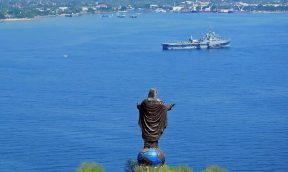
- Religious pilgrimage sites. One of the most important of these is Soibada which is overlooked by the Aitara Hill on which stands a great banyan tree
- Another site for religious pilgrimage is the summit of Mount Ramelau, where a statue of Virgin Mary is visited by many people who travel great distances to show their faith and devotion to God in a place of stunning natural beauty.
- Timor-Leste’s unique political and resistance history can also be promoted, including sites of significance such as the Santa Cruz Cemetery, the Resistance Museum and the Museum of the Timor-Leste Commission for Reception, Truth and Reconciliation, also known by its Portuguese acronym CAVR, which covers the events of 1975 to 1999 in Timor-Leste.
- Dili is also the gateway to the island of Atauro where tourists can experience a true tropical island getaway with pristine beaches, rural villages, trekking and fishing. There is a resort there, based on Eco-practices and run by an Australian company, but it is quite difficult to find information on how to access the island from Dili.
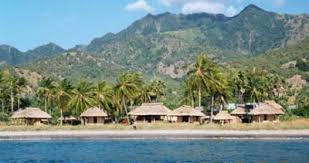
- The Central Zone could also be the main starting point for trekking and visits to the mountains of Timor-Leste. The stunning mountain town of Maubisse acts as a base for adventure tourism in this area, including trekking trips to climb Timor-Leste’s highest mountain, the sacred Mount Ramelau.
A successful tourism industry will contribute income to the national and local economies, create jobs, build businesses and improve regional economic imbalances.
The importance of the sector to Timor-Leste’s future will ensure that our infrastructure program prioritises projects such as upgrades to Dili and district airports, district seaports, roads and telecommunications.
Obstacles and Constraints
Back in 2001 the obstacles to tourism development were identified as:
- Shortage of funds for promotion
- Absence of market research
- Perception of East Timor from reporting during 1999 may deter potential visitors
It should also be noted:
- Another key challenge is the limited human resources available to service a growing tourist industry. Over 70% of Timorese live in rural areas with limited access to information and means of communication.
- Research indicates that poor levels of infrastructure,.
- high costs of rental transport and limited availability of readily consumable information relating to travel within Timor-Leste, are aspects which are lacking in order to meet visitors’ needs.
- Additionally, there exists limited access to cultural and historical sites within Timor Leste at present, and a lack of information about how to access sites.
Therefore this project will aim to provide a clear strategy plan for the Ministry of Tourism and tourism businesses to address the needs of travellers to Timor-Leste, and thus create an attractive environment within which the sector can flourish, building a destination image that will be attractive to the international market.
Research has also led to conclusions that, because, at the moment, costs of tourist attractions and facilities as well as transport to the country are generally much higher than those experienced in many other similar destinations, Timor needs to offer something unique and special in order for travellers to wish to spend extra money. Clearly the unspoilt beaches and the fact that there are so few other tourists around contribute to a unique selling point, but this still needs to be accessible, and the Maubere-Buibere Visitors Centre will play an important part in ensuring that these unique attractions are easily reachable, and that the quality of service throughout the visit is of a standard that will make the extra expense seem worthwhile.
Development Forecast for Tourism
In the Strategic Development Plan (SDP, 2011) the timeline for improvements was set out as the following
By 2015:
- Critical tourist infrastructure will have been built or rehabilitated, including the Dili airport and regional airports and improved telecommunications infrastructure
- Roads on key tourist routes, including the Great Northern Coast Road from Com to Balibo, and from Maliana through Ermera to Tibar, will have been rehabilitated and signposted
- A tourism and hospitality training centre will have been established in Dili
- Comprehensive tourist packages will have been developed for each of the Eastern, Central and Western Tourist Zones
- A tourist promotion marketing strategy will have been promoting Timor-Leste internationally for several years, including an annual calendar of special events
- Government will have been working with the private sector to develop tourism infrastructure that supports the key areas of eco-tourism and marine tourism, historic and cultural tourism, adventure and sports tourism, and conference and convention tourism
- Tourist Information Centres will have been established in Dili, Lospalos and Baucau
By 2020:
- Key tourism destinations will be operating with upgraded infrastructure, well established local activities and businesses, and promotional materials
By 2030:
- imor-Leste will have a well-developed tourist industry attracting a large number of international visitors, contributing substantially to national and local community income and creating jobs throughout the nation
Many of the aims for 2015 have yet to be achieved; although there is a Tourist Information Point at Cristo Rei, it is very limited and only open at certain times, what the city needs is a larger multi-functional Visitor Centre, that will not only provide for the needs of tourists but can also act as an umbrella governing the whole spectrum of tourism offers, facilities and services in the capital Dili and beyond. By doing this the centre will be a starting point for addressing each of the other aims in the SDP for 2015 and beyond.
Current levels of Tourist activity
Tourist Arrivals in East Timor increased to 15778 in the second quarter of 2016 from 15260 in the first quarter of 2016. Tourist Arrivals in East Timor averaged 15254.00 from 2011 until 2016, reaching an all time high of 25923.00 in the third quarter of 2013 and a record low of 11554.00 in the second quarter of 2011
An international tourist marketing strategy has been considered to promote Timor-Leste as a preferred destination for travel. This will include ‘branding’ Timor-Leste as an unspoilt boutique tourist destination, along with implementing an integrated marketing, advertising and public relations strategy. Tourism marketing will evolve as the economy grows and Timor’s tourism industry matures. At first instance, closer tourist operator relationships will be forged with Australia, Portugal, Indonesia, China, Malaysia and Singapore before extending globally.
Pre arrival Information and purpose of visit
Prior to arrival, three out of four travelers (75%) relied on word-of-mouth recommendations to inform them ahead of their trip to Timor-Leste. This included half of respondents (51%) who found information about Timor-Leste from friends and/or family living in Timor-Leste, and 24% of respondents who sought information from work colleagues.
An important consideration then is how to get more information out to potential visitors, and this needs to be taken into account as an element to this proposal. The Visitors’ Centre can provide a point not only for tourists when they arrive, but will be well-positioned to share information online and act as a central point for answering queries by phone or email.
Visitor Centre – Rationale and Planning
The main thrust of the proposal is the creation of a major centre for tourism in Dili, which will not only provide information and support for visitors but will become the hub of tourist activity in the area, integrating tourism offers and developing the already existing attractions. It will also create a brand and ensure that standards are maintained throughout tourism services.
The need for Tourist information in the centre of Dili
Nowadays travellers research their travel plans via a range of resources including the internet, television, magazines and newspapers and guidebooks. However, this information can often be too general because it is developed to cater to the widest possible audience. Also in the case of East Timor, where tourism is so new and developing, these media can quickly become out of date and inaccurate.
On arrival in Dili, visitors need local up-to-date information about the region’s attractions, events and services to ensure they have the best possible experience during their trip. At the same time local businesses, particularly micro- and small-to-medium enterprises, are forever looking for ways to promote their products and services directly to the consumer, and need to have direct access to this as they grow and establish themselves.
Therefore the Visitors’ Centre will fill the need for supporting visitors with their travel in a region, whilst at the same time supporting the local economy by providing local businesses with the opportunity to promote themselves directly to the consumer.
In addition the centre will offer local businesses – hotels, restaurants, car hire, transport and the attractions themselves – a platform for their services.
OBJECTIVES
- The prime function of the Visitors Centre will be to welcome and inform visitors through the provision of relevant assistance and services.
- To employ local people providing them with training in hospitality skills
- To use local resources – not imports
- To generate income to reduce operating costs.
- To enhance visitor enjoyment and encourage repeat visits as well as good word-of-mouth from visitors having returned home
- To liaise with and support local tourism providers
- To gauge customer satisfaction with our service
Full report and full porposal for East Timor Visitor Center availabe on request ……
Turismo Timor Leste
Turismo Timor Leste
2013 Carnival
Dili – Capital of East Timor
SUPER Timor-Leste… I don’t want too leave.
Last day in Timor Leste
Timor London Travel
Hi everyone, it is really exciting to be here to make a link between London, one of the oldest and most famous tourist destinations in the world by Visit England and Timor Leste, the newest and most exciting, a small South-East Asian island, 400km north of Australia with unspoilt beaches and a rich culture and history. From Darwin it’s just over an hour by plane. It has been named by The Telegraph ” The fifth world’s newest countiries” also noted by the BBC UK Still, very few visitors travel to the country, and its beaches are empty.
Our aim is to create connections between these two destinations, helping Timorese visitors to get the most out of their visit to London; while introducing the great attractions of the little known destination of Timor Leste to UK travellers with a desire to explore this new exciting undiscovered country.
What we do
We are…
View original post 586 more words
Travel to East Timor/ Timor Leste
By Air
Getting to Timor-Leste by air is easy, with international flights from Denpasar (Bali), Darwin (Australia) and Singapore. Dili is just over an hour away from Darwin by plane.
On arrival at Presidente Nicolau Lobato International Airport, a Timor-Leste Tourist and Business Visas (USD30 for 30 days) is granted to holders of valid passports. (Note: Portuguese are visa exempt when travelling for tourism). When departing a USD10 airport departure tax is required.
Dili is a 10 minute drive from the airport. To get into the city prearrange a transfer with your accommodation, book the 24-hour Flybus airport shuttle (USD10 per person; Tel +670 7750 8585) or organise a taxi (around USD10). (Note: With yellow taxis do negotiate fares prior to commencing your trip).
For more visa information: www.migracao.gov.tl
By Land
Journeying over land between West Timor and Timor-Leste, there are daily air conditioned minibus services linking the capitals of Kupang and Dili via the border crossing near Batugade. It is an arduous 12 hour trip through beautiful rolling hill country and along the scenic coastline west of Dili. All nationalities, with exception of Portuguese and Indonesians, must obtain a Visa Application Authorization before arriving at the land border post. Apply in person at a Timor-Leste Embassy or Consulate (there is one in Denpasar +62 3 6123 5093 and Kupang, Tel +62 813 3936 7558) or online at the Ministry of Immigration website (allowing around 10 working days to receive a printable authorization). Then present this document and the USD30 fee to Immigration at the border crossing.
For more visa information: www.migracao.gov.tl
Transport Operators
By Sea
While currently there are no regular scheduled passenger shipping services between neighbouring countries and Timor-Leste, recreational craft often stop in Dili and a few large passenger cruise ships are starting to ply Timorese waters. For those arriving by sea, Tourism and Business Visas (USD30 for 30 days stay) can be gained on arrival at the Sea Port in central Dili with presentation of valid passports. (Note: Portuguese travelling on Portuguese passports are visa exempt when travelling for tourism.)
For more visa information: www.migracao.gov.tl
Geography, Costume & Culture of Timor Leste
The culture of East Timor reflects numerous cultural influences, including Portuguese, Roman Catholic and Malay, on the indigenous Austronesian cultures of Timor. Legend tells that a giant crocodile was transformed into the island of Timor, or Crocodile Island, as it is often called. For example, East Timorese creation myth has it that an aging crocodile transformed into the island of Timor as part of a debt repayment to a young boy who had helped the crocodile when it was sick. As a result of that transformation, the island is shaped like a crocodile and the boy’s descendants are the native East Timorese who inhabit the island.Like Indonesia, the culture of East Timor has been heavily influenced by Austronesian legends, although the Catholic influence is stronger, the population being mainly Roman Catholic.
In terms of architecture there are still Portuguese-style buildings which sit alongside the traditional totem houses of the eastern region. The totem houses are known as uma lulik (sacred houses) in Tetum. Mere information here
Music
East Timor’s music reflects its history under the control of both Portugal and Indonesia, who have imported music like gamelan and fado. The most widespread form of native folk music was the likurai dance, performed to by women to welcome home men after war. They used a small drum and sometimes carried enemy heads in processions through villages; a modern version of the dance is used by women in courtship.
In the modern era, Timorese music has been closely associated with the independence movement; for example, the band Dili All Stars released a song that became an anthem in the build-up to the referendum on independence in 2000, while the United Nations commissioned a song called “Hakotu Ba” (by Lahane) to encourage people to register to vote in the referendum.
East Timorese popular musicians include Teo Batiste Ximenes, who grew up in Australia and uses folk rhythms from his homeland in his music. With many East Timorese people in emigrant communities in Australia, Portugal and elsewhere, East Timorese folk music has been brought to many places around the world. Refugee camps in Portugal mixed together East Timorese music with styles from other Portuguese colonies like Angola and Mozambique.
The guitar has long been an important part of East Timorese musc, though it is an import brought by colonizers; there, however, native kinds of string instruments similar in some ways to the guitar. Foreign influences also include popular styles of music like rock and roll, hip hop and reggae.
Religion
East Timor has been nominally Catholic since early in the Portuguese colonial period. The Catholic faith became a central part of East Timorese culture during the Indonesian occupation between 1975 and 1999. While under Portuguese rule, the East Timorese had mostly been animist, sometimes integrated with minimal Catholic ritual, the number of Catholics dramatically increased under Indonesian rule.In spite of accusations by the Suharto regime that East Timor’s independence movement, Fretilin, was communist, many of its leaders had trained to be priests, and their philosophy probably owed more to the Catholic liberation theology of Latin America than to Marxism.
Around 97% of the East Timorese population is Catholic, 2% Protestant, 0.3% Muslim, 0.5% have other religious beliefs. Indigenous religions revolve around an earth mother, from whom all humans are born and to whom they return after death, and her male counterpart, the god of the sky or sun. These are accompanied by a complex world of ancestor, nature and evil spirits.
However, in spite of the majority of the country’s people now being Catholics, there is freedom of religion in the new republic, and the Prime Minister Marí Alkatiri, is a Muslim of Yemeni descent.
Timor London Travel
Hi everyone, it is really exciting to be here to make a link between London, one of the oldest and most famous tourist destinations in the world by Visit England and Timor Leste, the newest and most exciting, a small South-East Asian island, 400km north of Australia with unspoilt beaches and a rich culture and history. From Darwin it’s just over an hour by plane. It has been named by The Telegraph ” The fifth world’s newest countiries” also noted by the BBC UK Still, very few visitors travel to the country, and its beaches are empty.
Our aim is to create connections between these two destinations, helping Timorese visitors to get the most out of their visit to London; while introducing the great attractions of the little known destination of Timor Leste to UK travellers with a desire to explore this new exciting undiscovered country.
What we do
We are a new independent tourism consultancy with a mission to make connections between East Timor and London. With over twelve years’ experience in UK tourism and hospitality, and full in-depth local and national knowledge of East Timor, we are ideally equipped to deal with your holiday wishes and even go beyond the bounds of tourism in forging links between the two destinations, whether you are –
IN THE UK

- In the UK
We aim to provide UK travellers with all they need to visit and explore the unique destination of East Timor, with its unspoilt beaches, vibrant culture, fascinating history and breathtaking scenery.
With expert knowledge of the destination’s offers and fluency with communication.
We can also offer UK travellers advice on :
- finding voluntary work or placement in Timor Leste, if you want to learn the language or about the history, so that you can support the East Timor community while enjoying this new undiscovered destination, we can connect you to the right people in East Timor
- preparing for your visit; travel related documents for your visit
- travel, attractions, amenities, accommodation and the best activities to suit you
- drawing up an itinerary for your stay
- liaising with your hosts to ensure a smooth and successful time on this special island. We can do this for you.
- Investing in this newly established nation. We can connect you to the right people for business, banking or sustainable development tourism projects to help our country. Retail, manufacturing, construction, arts, entertainment, recreation wholesale trade.
- Seeing the wide-ranging, diverse aspects of this new, undiscovered destination, while supporting local business (community based tourism services in Timor). We can make the connections, so that your visit is as enjoyable as possible.
…OR IN EAST TIMOR
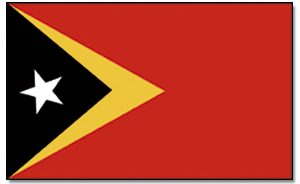
For visitors from East Timor, we specialise in fun, informative and unusual ways to see London. Choose from a menu of pre-designed guided tours or let us put something together especially for you.
Led by a Timorese guide with vast experience of London, fluent in Tetum, Portuguese, Spanish, Indonesian as well as English, we can offer anything from a walking tour of the sights to a full exploration of London and surrounding attractions over several days.
Our aim is to take you to see unusual aspects of the city while getting you the best deals to save you money (restaurants, transport, amenities and services around london) so that your visit is as enjoyable as possible.
And with specialised knowledge of the languages and culture in both destinations, we can make sure you get the very best out of your visit without spending too much.
Additionally For East Timorese coming to London we offer advice on :
- looking for voluntary work, to learn English or even to get access to the higher education in the UK we are here to help
- If you want to expand your business in the UK and looking to work together with western investors from banking industry, travel and tourism industry or even small businesses, Timor London is here to connect with these companies
- We aim to connect investors and business who are interested in expanding their market and explore new destination and new products
Wherever you are coming from and whether your interest is in business or pleasure, we can help you find the solution to your enquiry. So drop us an email or give us a call at Timor London Travel, telling us what you are interested in; and we will get to work on fulfilling your desires.
